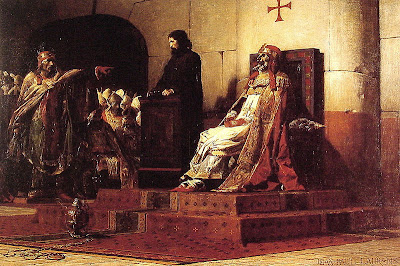(896-897)
Also called Stephen VII, this Pope's short reign is mostly known for having put on trial the previous Pope...who was dead. Stephen ordered the body of Pope Formosus exhumed, dressed in the Papal vestments, and set upon a throne. In what is known as the Cadaver Synod, Stephen charged the rotting corpse with perjury, coveting the Papacy, and breaking other church laws. During the trial, Pope Stephen screamed at Formosus, as well as mocked and insulted him.
Formosus was found guilty, and was punished by having his clothes stripped off, three of his fingers chopped off, and the rest of the body thrown into the Tiber River.
Stephen's reign did not last much longer - he was strangled to death.
Pope John XII
(955-964)For much of the tenth century, the city of Rome was dominated by the Theophylact family, and they often made the decision who would sit on St. Peter's Throne. Perhaps they didn't have too many choices, but it is hard to imagine they could not have picked someone better than John XII, who is about 18 years old when he became Pope. His youth had one benefit, as began his pontificate by personally leading armies against the local enemies.
However, it soon became apparent that John was more interested in the women of Rome than in handling church affairs. His antics eventually led to Emperor Otto I calling a synod to depose the young Pope. According to one chronicler, the charges against John included:
He had fornicated with the widow of Rainier, with Stephana his father's concubine, with the widow Anna, and with his own niece, and he made the sacred palace into a whorehouse. They said that he had gone hunting publicly; that he had blinded his confessor Benedict, and thereafter Benedict had died; that he had killed John, cardinal subdeacon, after castrating him; and that he had set fires, girded on a sword, and put on a helmet and cuirass. All, clerics as well as laymen, declared that he had toasted to the devil with wine. They said when playing at dice, he invoked Jupiter, Venus and other demons. They even said he did not celebrate Matins at the canonical hours nor did he make the sign of the cross.
Pope John retaliated by excommunicating the synod, and when he caught three of the men who took part, he had one flogged, cut off the right hand of the second, and removed the nose and ears of the third. Alas, his reign ended soon after, at the age of 27, when was "stricken by paralysis in the act of adultery" and died.
Pope Benedict IX
(1032 - off and on to 1048)
Another descendant of the Theophylact family, Benedict was at least 20 when he became Pope. Sexual scandals soon started, leading many church officials to complain about him. The Abbot of Monte Cassino, who later became a Pope too, wrote about "his rapes, murders and other unspeakable acts. His life as a pope was so vile, so foul, so execrable, that I shudder to think of it."
What also sets Benedict apart from most other popes was that he resigned as well. Unlike Pope Benedict XVI, who resigned because of his old age, this Benedict resigned in exchange for a large sum of money - bribed by his godfather John Gratian, who then became the new Pope, Gregory VI. However, Benedict soon had seller's remorse, and over the next Rome and the St.Peter's was fought over between the various sides. Eventually the German Emperor came down and removed all the contenders, naming a new Pope. Benedict lived on until 1056, but never regained the Papacy.
Pope Boniface VIII
(1294-1303)Before he became Pope, Boniface was instrumental in persuading his predecessor, Pope Celestine V, to retire. Once he got to the Papal Throne, Boniface decided that having Celestine around was too much of a threat, so he captured the elderly man and imprisoned him until his death ten months later.
Most of his reign was spent in conflicts with the other states in Italy, but Boniface got in trouble when he decided to pick a fight with Philip IV, King of France. Eventually, he excommunicated the French king and proclaimed that all monarchs were subordinate to the Papacy. Philip responded by sending an army into Italy, where they captured Boniface at his summer retreat in Anagni. The French troops beat up and nearly killed Boniface - three days later he was dead, perhaps killing himself.
The Italian poet Dante, in his work The Divine Comedy, has Boniface relegated to the eight circle of hell for simony.
Pope Alexander VI
(1492-1503)While he may not have been guilty of all the deeds depicted in the popular show The Borgias, Pope Alexander VI was one of the most notorious schemers to hold the papacy. He made many efforts to enrich his family and get his children into positions of power, and he also had enough time to have a mistress.
His death in 1503 is something of a mystery - Alexander may have been poisoned, and his son Cesare Borgias was suspected of committing the crime. Rumours soon spread, aided by the rapid decomposition of Alexander's remains. One person who saw the body commented, "It was a revolting scene to look at that deformed, blackened corpse, prodigiously swelled, and exhaling an infectious smell; his lips and nose were covered with brown drivel, his mouth was opened very widely, and his tongue, inflated by poison, fell out upon his chin; therefore no fanatic or devotee dared to kiss his feet or hands, as custom would have required."









